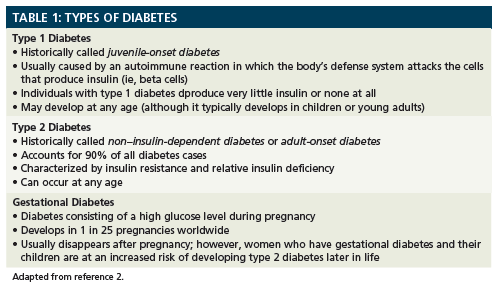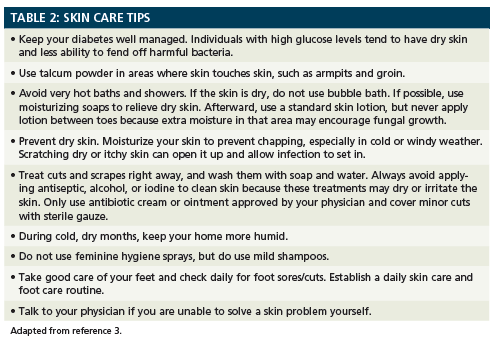Skin Problems in Diabetes: Often the First Sign
Diabetes is a chronic condition that affects more than 380 million individuals worldwide.

Diabetes is a chronic condition that affects more than 380 million individuals worldwide. The World Health Organization is estimating this number will exceed 550 million by 2030, causing a great strain on health care.1
Diabetes occurs when the pancreas is unable to produce sufficient amounts of insulin or when the body is ineffective at using insulin, a hormone required for the regulation of blood glucose in the body.1,2 The 3 main types of diabetes (Table 12) are type 1, type 2, and gestational, which are characterized based on pathophysiology.1,2
Complications
Hyperglycemia is a hallmark sign of uncontrolled diabetes. Individuals with hyperglycemia typically experience excessive thirst and increased frequency of urination due to an elevated blood glucose level. If hyperglycemia is not managed properly, diabetes is likely to result in serious health complications over time,2 including cardiovascular disease, neuropathy, nephropathy, and retinopathy.
Diabetes also affects the skin in a number of ways, many of which can be reduced or prevented with proper strategies.3 Diabetes-related skin complications can be the first sign of the development of diabetes. Therefore, proper skin care in diabetes is extremely important and an area where pharmacists can play a role on the front line of health care. As many as one-third of individuals who have diabetes experience a skin disorder caused or affected by the disease at some time in their lives.3 Patients with diabetes are more prone to the development of skin complications. Bacterial and fungal infections, as well as itchy/dry skin, are also commonly associated with the disease.3,4 The primary component of diabetic skin care includes preventive strategies aimed at prophylactic skin care, foot care, and nail care, as well as increased emphasis on the importance blood glucose control.4

The human body attempts to rid itself of excess glucose by increasing urine output. This loss of fluid, coupled with poor blood circulation to the skin, may result in drying of the skin and lead to other skin problems, such as itching. This frequently leads to small breaks in the skin, thus increasing the susceptibility to infections.5 The drying of the skin can be minimized by moisturizing with lotion or creams to prevent the aforementioned infections.6
Counseling Points
When counseling patients with diabetes, it is essential that pharmacists stress the importance of tight glycemic control. Diabetes-associated complications, including skin issues, can be minimized with the appropriate management of the disease state itself.4,5 Pharmacists should ensure patients have a sufficient understanding of their condition and the ability to adhere to their care regimen, and should encourage patients to become active partners in their care.6
Pharmacists should discuss general skin care recommendations for patients with diabetes (Table 23). They may recommend nonprescription dermatologic products that address the specific skin care needs of the patient, as well as discuss situations that warrant further medical attention.5 More specifically, pharmacists have the ability to assist in the development of a skin and foot care routine that may further decrease possible skin-related complications.
Dr. Moore is an assistant professor at Howard University College of Pharmacy.
References
- Diabetes: key facts. World Health Organization website. www.who.int/mediacentre/factsheets/fs312/en/. Updated January 2015. Accessed September 10, 2015.
- What is diabetes? International Diabetes Federation website. www.idf.org/worlddiabetesday/toolkit/gp/what-is-diabetes. Accessed September 13, 2015.
- Skin care. American Diabetes Association website. www.diabetes.org/living-with-diabetes/complications/skin-care.html. Updated February 24, 2015. Accessed September 17, 2015.
- Terrie YC. Managing skin complications in patients with diabetes. Pharmacy Times website. www.pharmacytimes.com/publications/issue/2011/october2011/managing-skin-complications-in-patients-with-diabetes. Published October 10, 2011. Accessed September 13, 2015.
- Leveriza-Oh M. Diabetes and your skin. Diabetes Self-Management website. www.diabetesselfmanagement.com/about-diabetes/general-diabetes-information/diabetes-and-your-skin/. Published August 13, 2009. Updated October 29, 2013. Accessed September 13, 2015.
- Kraft JN, Lynde CW. Moisturizers: what they are and a practical approach to product selection. Skin Therapy Lett. 2005;10(5):1-8.

